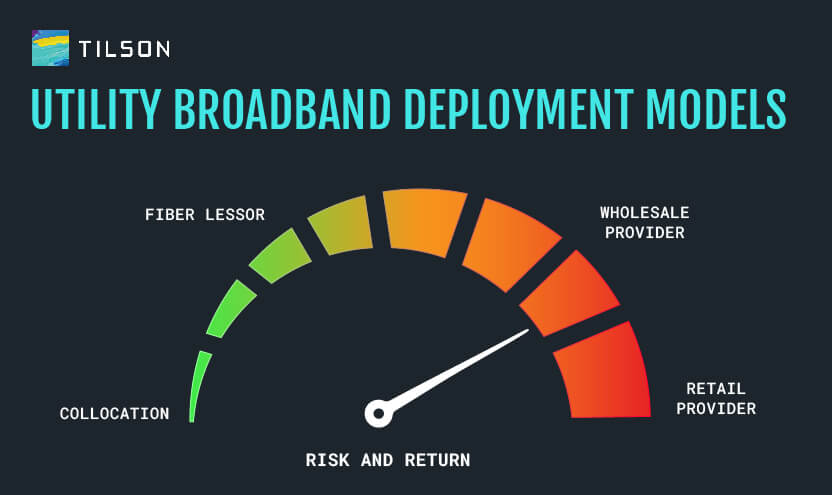Billions of dollars in federal funding opportunities have ushered in a “Golden Age” for utility broadband deployment projects that provide essential services to customers such as telehealth, education, and economic opportunities. These broadband investments, once outside the scope of possibility, are now viable opportunities for utilities to both maximize their network investment and provide a critical service to their communities.
Recently, CEO Josh Broder and I presented at The Utility Technology Council (UTC)’s Utility Broadband Workshop on the variety of utility broadband deployment models. Rather than a one-size-fits all approach, utilities have a spectrum of options to choose from to best align with their specific goals, customer needs, and ability to take on risk.
If you do not yet have a strong partner to plan, design, and build your utility broadband network, contact us to discuss your specific goals or learn more about Tilson’s comprehensive utility consulting and network deployment services.
Utilities can participate in broadband deployment in a variety of different ways, depending on their organization’s specific goals, customer needs, regulatory obligations, and ability to take on risk.
“There’s a spectrum of ways to engage in broadband and satisfy the common interest that all utilities have in seeing economic development and prosperity,” said Tilson CEO Josh Broder. “There are a number of ways to do that. And utilities are finding different answers that are appropriate to their facts and circumstances and their commission’s oversight.”
The graphic below illustrates the engagement level of utilities and the corresponding level of risk they are willing to take to support broadband. On the left are lower risk, lower effort activities such as collocation and on the far right are higher risk, higher reward opportunities such as becoming a broadband provider.

The varying ways in which utilities can support broadband often begins with collocation. Typically, as either sole or joint owners of poles and conduit in the rights-of-way, utilities already have the necessary infrastructure to support broadband deployment by a third-party such as an internet service provider (ISP). Collocation is also often a regulatory obligation in most contexts. Having a willing and interested utility party to support collocation of an ISP’s broadband is an important ingredient, and utilities can play an extremely valuable role just by being good stewards of their existing facilities.
This option falls on the far left of the scale, where there is less risk involved and less return expected.
More proactively, many utilities are actively leveraging their facilities such as dark fiber and communications towers to support broadband deployment either as a business model, with community partners, or both. We see utilities starting to lease out strands of fiber from their own grid control and then deploy additional fiber, perhaps more than they would have deployed for grid control purposes and lease that fiber out to telecom carriers. In this model, there is more risk, more engagement, more capital on the line, and more work with commissions to figure out recovery structure. However, this model still does not change fundamentally what the utility does – it just makes spare capacity available on a facility that probably needs it anyway for long-term grid modernization.
Becoming a wholesale provider represents a more involved option. We usually see community-owned utilities in this space more often than investor-owned utilities. As a wholesale provider, utilities enable retail telecom companies ISPs to serve an end customer, essentially delivering them to the door.
At the most engaged level, we see utilities moving into the business of being retail providers and providing a second non- or lightly-regulated service.
Several of our recent utility consulting clients illustrate the variety of ways utilities can invest in broadband.
In Vermont, in the Collocation category at the left end of the spectrum, we worked with Green Mountain Power (GMP), VELCO, and Vermont Electric Co-op (VEC) to find a model through which they could support broadband deployment to unserved customers without being an ISP or leveraging utility assets. We identified that make-ready costs were extremely high, creating a barrier for entry; estimates were as high as $40,000 per mile because of the rural nature of the area, the age of the utility poles, and challenging topography.
To solve this problem, we worked with the utilities and commission to create a temporary make-ready subsidy – officially known as a “temporary unserved location broadband rider” – that provides $2,000 per unserved premises that a network reaches.
This innovative and first-of-its-kind model facilitates collocation and reduces the cost for new networks. This project also represents how you can be on the left side of the spectrum but still make a large impact on broadband access.
Utilities have a spectrum of options to choose from when investing in broadband deployment. Together with billions in available funding opportunities, the choices and flexibility utilities have to support broadband deployment, even if they do not want to be an ISP, underscores that there is no better time to invest in utility broadband infrastructure. Utilities are in the unique position to use this funding to both maximize their network investment and provide essential broadband access to unserved customers.
If you do not yet have a strong partner to plan, design, and build your utility broadband network, contact us to discuss your specific goals or learn more about Tilson’s comprehensive utility consulting and network deployment services.